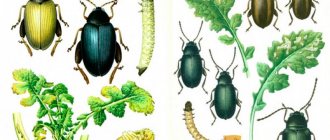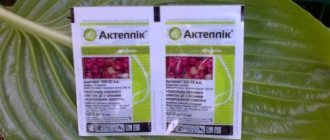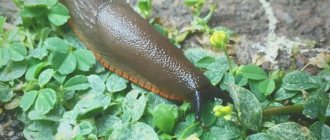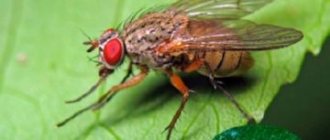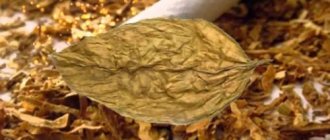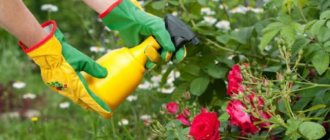Cruciferous flea beetle: description
An insect from the family of leaf-eating beetles, it belongs to the species of flea beetles. An adult specimen does not exceed 2.5 mm in length and has a blue, black or dark green body color.
The flea beetle can jump, moving from one plant to an adjacent bush. Over the summer it produces 2-3 generations of individuals. The insect overwinters in the surface layer of soil, at a depth of up to 7 cm, under plant debris, emerging to the surface with the arrival of heat.
The cruciferous flea beetle is distributed throughout Eurasia, right up to the Arctic. Insect larvae feed on young leaves of cabbage, radishes, lettuce, rutabaga, and turnips, leaving numerous round holes on the leaves.
Know the characteristics of pests
Several species of insects parasitize cabbage. The methods of struggle are the same for everyone.
Cruciferous flea beetle
| Appearance Commonly called a black flea. ')); (w||(w=[]))&&w.push({id:b,block:'14502'});})(window,document,"mtzBlocks"); The color of the insect is black, with a silvery sheen on the elytra. The size is no more than 3 mm. The species is distributed throughout European and Asian territory |
Light-legged flea beetle
| Appearance The flea is distinguished from its relatives by the light color of its legs. The color of the back varies from black to light brown. There are long light antennae on the black head. The body length is 3–3.5 mm. Prefers southern regions of Europe and Asia |
Blue flea beetle
| Appearance A blue flea can be confused with a black flea. The difference is the blue-green tint of the back and wings. The variety has long antennae. Body 2 to 3 mm long. Wide habitat. The main places of distribution are on the European part of the continent, in the Caucasus. Often found in Western Siberia |
Wavy flea beetle
| Appearance It is not difficult to distinguish a flea from its relatives by the wide yellow stripes on the sides of the wings. The individual is small in size - 2.5–2.8 mm. The main places of distribution are in the Urals and the Far East, in Siberia |
Causes and signs of appearance:
| Causes: 1. Flea beetle larvae are found in the soil. The pest can be easily introduced into untreated turf soil. 2. Insects are excellent jumpers. They migrate freely over long distances. 3. Initially, the insect develops on weeds of the cruciferous family. The female lays eggs in the ground or on weed leaves. Adults overwinter in crevices of paths, soil, and under plant debris. When it gets warm, they begin their harmful activities. Particularly active during dry periods of summer. Signs: 1. Bugs are visible to the naked eye on cabbage leaves. 2. Holes appear on the sheet plates. When the pest population is large, only veins remain. 3. The larvae, while developing, gnaw the roots. The plant turns yellow and dries out. 4. Adults prefer young plants |
Why are cruciferous flea beetles dangerous for cabbage?
For the cabbage flea beetle, there is nothing tastier than the tender foliage of cabbage seedlings just placed in the garden bed. Young, immature plants are attacked by the pest and can dry out from insect damage.
The flea gnaws numerous holes on the leaf plate, depriving the plant of the ability to function normally. Damaged leaves dry out and the plant stops growing.
A flea attack on adult cabbage plants is not as dangerous as on seedlings; the cabbage will not die. But the pest is a carrier of diseases; its activity weakens the plant’s immunity and spoils the appearance of cabbage.
Signs of a flea
The pest is called the garden, or earthen, flea. Features:
- it can be black with a white stripe in the middle and yellow paws, with black and yellow stripes, a brown back with a bronze tint, green elytra with a blue tint - the color depends on the species;
- elongated shape;
- long mustache;
- strong and long hind legs.
The life cycle begins with the first warming.
Parasites choose only seedlings as a home; they cannot gnaw the rough leaves of adult plants. When pests attack a vegetable at the head setting stage, they make holes in the leaves. It is through these small but numerous holes that the presence of an insect is detected. The larvae eat the stem and roots. The entire plant is attacked. The seedlings become weak, lose turgor and dry out even with constant watering.
Fleas can be seen if you touch a bush - the insects will jump out of their hiding places.
How to get rid of fleas on cabbage using folk remedies
The most effective way to get rid of pests is to spray the plants with insecticides designed to combat harmful insects. But such preparations are also harmful to beneficial insects and cannot be used on crops with a short growing season, due to accumulation in plant tissues.
To combat cruciferous flea beetle, there are many folk remedies that effectively eliminate the pest from the garden. But these products will have to be used more often than chemicals due to their weak impact.
Most folk remedies are aimed at repelling the pest, and not at destroying it.
Ash (watering, dusting)
Wood ash is used to repel harmful insects from cabbage plants; it does not harm them. The sifted ash powder is applied to the cabbage seedlings, dusting them on all sides. A thin layer of ash mechanically prevents the pest from entering the plant and removes the smell of cabbage.
Important! Only ash from burning wood, grass, hay and straw is used. Products from burning plastic, polyethylene, painted wood, and printing products are not suitable as they are poisonous.
For dusting, small sieves are used or “sprayers” are made from plastic bottles (holes are made in the sides and bottom of the bottles with a hot awl). Ash sticks to the foliage better if you dust the plants after watering.
Unfortunately, precipitation washes the ash off the cabbage, negating its protective properties. Dusting with ash and other means is used in dry weather to prolong the effect of the drug.
On a note. For the best effect, the ash is mixed with ground red or black pepper, dry mustard powder in arbitrary proportions (more often the ingredients are taken in equal quantities). This mixture is absolutely harmless to people and plants, but does not give insects the opportunity to feast on cabbage leaves. Applying this composition to the soil around the plants also repels snails and slugs from the cabbage.
ash infusion is successfully used , which is also a phosphorus-potassium fertilizer for the plant:
- In a bucket (10 l) of warm water, stir 2 kg of sifted wood ash and leave in a warm place for 2 days.
- Add 2-3 tablespoons of liquid laundry soap or dishwashing detergent to the finished infusion so that the solution sticks better to the leaves.
You can bathe cabbage seedlings in the resulting infusion of ash before planting or pour the plants from a watering can with a sprayer. Apply the infusion every 10 days until the flea insect disappears from the garden.
Dusting with tobacco dust
The use of tobacco dust gives a similar effect to dusting with ash. The pungent smell of shag takes away the natural aroma of cabbage, and pests are not interested in the garden bed.
For dusting, use pure tobacco or shag, grinding it into dust. Cabbage seedlings are pollinated with tobacco immediately after planting, even if the flea beetle is not visible in the garden. The purpose of the treatment is to hide the plants from the pest and prevent it from coming to the garden.
After the rain, pollination of cabbage with tobacco dust will have to be resumed. In order for tobacco dust to linger better on smooth leaves, the plants are first sprayed with water or a soap solution in a weak concentration (1 tablespoon of liquid soap per 5 liters of water).
Vinegar
To spray cabbage, use table vinegar 9% or 70% acetic acid. The effect of using the solution is the same, only the dosage differs. Take 0.5 cups of table vinegar per 10 liters of lukewarm water; 2 tablespoons of acetic acid per bucket is enough.
The solution is generously irrigated from top to bottom, once a week. The smell of vinegar repels the flea beetle, and the sour taste that the foliage of the plant acquires is not to the taste of the pest.
Attention! If cabbage grows in acidic soil, using a vinegar solution is not recommended. It will only acidify the soil more. To protect the plant from cabbage flea beetle, ash infusion is used.
The vinegar solution does not affect the taste of cabbage, so it can be used until harvesting.
Irrigation with alcohol solutions
To combat the pest and accompanying foliar feeding of cabbage with nitrogen, ammonia is often used. 1 tbsp. A spoonful of ammonia is dissolved in 3 liters of water and the plants are immediately sprayed. Alcohol quickly evaporates from water, so the solution cannot be stored. Fleas do not like the pungent smell of ammonia; they ignore such odorous beds.
Some gardeners successfully use aqueous solutions of cologne or inexpensive, strong-smelling eau de toilette. 1-2 tbsp. spoons of the drug are dissolved in 3 liters of water, which is enough to treat 20-30 plants. You can spray cabbage with aromatic infusions every week; they will not harm the plants. The effect of this treatment on insects persists until the aromatic substances evaporate from the leaves.
Read more in the article: Slugs on cabbage - how to deal with them
Herbal infusions
Decoctions and infusions of herbs and tops of garden plants are successfully used against cruciferous flea beetles, cabbage moths and other pests. They are all prepared according to the same recipe.
- The chopped grass is placed in a bucket (9-10 l), filling it by a third.
- The mass is poured with hot water and infused for 10-12 hours.
- The infusion is placed on the fire and brought to a boil, then turned off. The broth is cooled and filtered.
- Before spraying the cabbage, the herbal decoction is diluted with water, increasing the volume by 2 times. To better retain the composition on cabbage leaves, add 2-3 tablespoons of liquid laundry soap to the solution.
The frequency of treatments of cabbage with herbal decoction is once every 7-15 days, until the pest is completely expelled. For processing, choose windless, clear and dry weather.
The following plants are used as raw materials for preparing the decoction:
- tomato (you can take torn shoots from plants) and potato tops;
- garlic and onion feathers;
- wormwood grass, tansy;
- dandelion leaves, celandine.
All plants used to prepare the infusion should not be rotten or diseased.
Fresh grass or tops also have a good effect. It can be laid out on the ground around the cabbage.
Know how to properly care for cabbage in open ground
| Feed From the moment of planting in the beds until harvesting, feed the cabbage 3 times. The first is to pour chicken manure infusion at the root on the 14th day after planting, diluted at the rate of 1 part infusion to 15 parts water. Urea is suitable as a mineral supplement (per 10 liters of water - 100 g of fertilizer). The second is to feed two weeks after the first fertilization with mullein infusion with the addition of “Superphosphate”. You can replace the purchased phosphorus additive with clean wood or straw ash. The third is to apply potassium fertilizer during the appearance of heads of cabbage. | |
| Water 1. Water young plants often - once a day, half a liter of water per bush. 2. Gradually increase the amount of water at the rate of 2 liters per seedling bush. 3. When the heads of cabbage begin to set, up to 4 liters of water per plant will be needed. You can’t pour water right under the root collar. The water stream passes along the edge of the hole. It is better to arrange drip irrigation. 4. To avoid the appearance of cabbage fleas, keep the holes slightly moist. In the first weeks, before strengthening, mulch the soil with straw. Water with cold water | |
| Fight against harmful insects Cabbage is often attacked by pests. When planting, disinfect the soil with potassium permanganate. Two weeks before transplantation, treat with insecticidal solutions. For example, “Denis”, “Atom”. Copper sulfate is a cheap, effective means for spring prevention against fungal diseases and pests on the site. Spray the entire garden plot generously |
You can learn more about the rules for caring for cabbage in open ground by watching the video here
Treatment of cabbage against flea beetles with biological preparations
To protect garden crops from harmful insects, biological insecticides have been developed that do not harm beneficial living beings and do not accumulate in plant tissues.
Fitoverm and Actofit are used against cruciferous flea beetle.
Aktofit is a yellow liquid. The active ingredient is aversectin, which has a paralyzing effect on the nervous system of the pest. The drug can be used without time restrictions, including during the harvest period. Analogues of Aktofit are: Akarin, Nisoran, Mitak, Konfidor.
Cabbage is treated with the drug several times a season, achieving complete destruction of insects. The dosage of the drug is 6 ml per 1 liter of water.
Fitoverm is a preparation made from soil fungi. Its action is similar to that of Actofit, penetrating into the intestinal tract of the insect, the substance has a paralyzing effect, the pest dies.
Fitoverm “works” for 2-3 weeks, after which the treatment can be repeated. The dosage of the drug for cabbage is 4 ml per 1 liter of water. Plants are sprayed generously, trying to get the solution onto the leaves and from the underside.
Mechanical methods of controlling flea beetles on cabbage
Since the pest overwinters in the surface layer of soil, insects can be destroyed by carefully digging up the bed after the onset of stable frost. All plant debris should be removed from the ground, depriving the flea of shelter.
Insects emerge from their winter shelters when the air temperature warms up to +7 +9 degrees. At this time, their food is weeds, especially the flea “to taste” quinoa, mustard, and shepherd’s purse. By removing all weeds from the site, you can significantly reduce the number of flea beetles.
When sowing green manure to improve the soil, do not sow mustard in the area intended for planting cabbage.
Some gardeners use mulch, covering the soil with a 7-12 cm thick layer of grass or straw when the soil warms up in the spring. Such cover prevents the wintering pest from emerging and it dies. This method of fighting cabbage flea beetles cannot be called good specifically for cabbage, since slugs can hide under the mulch.
Instead of vegetable mulch, use black non-woven material, spreading it over the surface of the bed. Cabbage seedlings are planted in the holes made in it. The material prevents weeds from growing and prevents flea beetles from emerging from the soil. The top of the cabbage can be covered with white lutrasil or agrospan, stretching it over the arcs. The material allows light, air and moisture to pass through, but completely protects the plants from any harmful insects.
Prevention
Arches should be placed over the bed with cabbage seedlings planted, and a thin white covering material should be stretched over them. Lay the ends of the material on the ground and press down with boards. Access for fleas will be closed. The cover can be left in place until it becomes too small for the cabbage.
In the fall, after cutting the heads of cabbage, all plant debris must be removed and the bed must be dug up. It is better not to break the clods so that the overwintering larvae and beetles freeze out.
Cruciferous crops should not be planted next to each other. It is better to place them in different parts of the garden. It is advisable to observe crop rotation. Cabbage should be returned to the place where cruciferous vegetables grew no earlier than after 2–3 years.
Sprinkling cabbage plantings daily in hot weather will repel bugs. They don't like dampness. If there is no dew on the plants in the morning, then irrigation with water can be carried out twice, in the evening and in the morning.
Watering should be regular as the soil dries. Cabbage is a moisture-loving plant, but flea beetles are not.
What plants can repel pests?
Fragrant herbs and some flowers release phytoncides into the air - volatile substances that repel the cruciferous flea beetle and some other pests. It is recommended to plant in the same bed with cabbage:
- dill, fennel;
- marigolds and calendula;
- garlic.
Spraying cabbage with aqueous solutions of aromatic oils from these plants will also repel flea beetles.
Preventive measures
Having summarized the measures to combat the cruciferous flea beetle, we can derive several rules for growing cabbage, which are aimed at preventing the appearance of the pest.
Maintain crop rotation. Cabbage and plants of the same family (horseradish, radishes, turnips, turnips, salads) are not planted one after another in one place. Cabbage is returned to its original place of cultivation no earlier than 4 years.
It is useful to alternate cabbage with crops that are not attacked by pests: garlic, potatoes, tomatoes, peppers, onions.
The beds are kept clean, removing weeds as soon as they appear. So the flea is deprived of food even before the cabbage seedlings are planted and leaves.
The cruciferous flea beetle loves dry air, so after planting the seedlings it is recommended to water the plants with a watering can over the foliage.
Types and danger of cabbage fleas
The following types of cruciferous flea beetles can be found on cabbage leaves:
- Lightfooted. They prefer young plants of the cruciferous family. They have a metallic dark body color and a yellow head. They reach sizes of 4 mm. Their larvae, unlike other species, also feed on foliage.
- Black. Black flea beetles eat cabbage most often. They can be identified by the uniform dark color of the body, measuring 2-3 mm.
- Wavy. They have a dark-colored body and a yellow stripe on the wings. Also common.
- Notched. There are several yellow stripes on their black body. Not only cruciferous plants can be damaged, but also other vegetables.
Cabbage flea beetles eat 3 times their weight in one day and quickly gnaw off the leaves.
They are especially dangerous for seedlings and seedlings, since they prefer to eat the upper part of the plant and often infect the growing point. Did you know? Cruciferous flea beetles belong to the tribe of earthen flea beetles from the subfamily of beetles of the leaf beetle family. There are about 400 species of these insects in the CIS countries, and in total there are about 5,000 species in the world.
